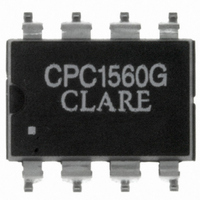CPC1560GSTR Clare, CPC1560GSTR Datasheet - Page 8

CPC1560GSTR
Manufacturer Part Number
CPC1560GSTR
Description
RELAY OPTOMOS SP-NO 600MA 8-SMD
Manufacturer
Clare
Series
CPC, OptoMOS®r
Datasheet
1.CPC1560GSTR.pdf
(14 pages)
Specifications of CPC1560GSTR
Circuit
SPST-NO (1 Form A)
Output Type
AC, DC
On-state Resistance
5.6 Ohm
Load Current
600mA
Voltage - Input
1.22VDC
Voltage - Load
0 ~ 60 V
Mounting Type
Surface Mount
Termination Style
Gull Wing
Package / Case
8-SMD (300 mil)
Lead Free Status / RoHS Status
Lead free / RoHS Compliant
Other names
CLA305TR
Available stocks
Company
Part Number
Manufacturer
Quantity
Price
Company:
Part Number:
CPC1560GSTR
Manufacturer:
CIRRUS
Quantity:
1 439
CPC1560
2. Introduction
The CPC1560 is an optically coupled Solid State
Relay (SSR) that is self-biased from the load supply.
An external charge storage capacitor is used to greatly
speed up SSR turn-on. The CPC1560 also
incorporates current limiting and a thermal shutdown
feature in the output circuitry, which make the device
ideal for use in harsh conditions.
3. Functional Description
Internally, the device is composed of an LED, a
photovoltaic array with control circuitry, and two
MOSFET output switches.
Input current to the LED is the turn-on signal to the
SSR’s output MOSFET switches. The LED illuminates
the photovoltaics, which provide current to the gates of
the output MOSFETs, causing them to conduct. The
charge provided to the MOSFET gates initially
includes the charge stored in the external capacitor,
which causes the SSR to conduct much more quickly
than if only the photovoltaic current were used.
When the Load Voltage (V
inactive outputs, the external storage capacitor begins
to charge. To ensure proper operation, the storage
capacitor should be equal to or greater than the total
gate capacitance of the two output MOSFET switches.
The charge is passed through bootstrap diodes, which
prevent the charge from escaping and discharging the
capacitor through the MOSFET output switch when
the SSR is turned on. The input control current is
applied, then the charge is transferred from the
storage capacitor through the internal NPN bipolar
transistor along with the charge from the photovoltaic,
to the MOSFET gates to accomplish a rapid turn-on.
After the capacitor has discharged and the MOSFETs
have turned on, the photocurrent from the photovoltaic
continues to flow into the gates, keeping the
MOSFETs turned on.
When the input control current is removed, the gate
current stops flowing and the PNP bipolar transistor is
on, discharging the MOSFET gates. The MOSFETs
are now off. At this point the capacitor begins to
recharge for the next turn on cycle.
The non-conducting, optical coupling space between
the LED and the photovoltaics provides 3750V
isolation between the control input and the switched
output of the CPC1560.
Important things to note about the operation of the
CPC1560:
•
8
The device is designed to maintain its guaranteed
operating characteristics with DC input control
current (I
F
) in the range of 2.5mA to 10mA (see
L
) is first applied to the
rms
of
PRELIMINARY
•
•
The CPC1560 has two different operating
configurations: unidirectional DC-only configuration,
and bidirectional AC/DC configuration.
In the unidirectional DC-only configuration, the device
switches load voltages with a fixed polarity, while in the
AC/DC configuration it can switch voltages with either
positive or negative polarities.
The advantage of operating the device in the DC-only
configuration is the ability to switch larger load
currents. The advantage of operating it in the AC/DC
configuration is the flexibility of switching load voltages
of either polarity.
4. Device Configuration
4.1 LED Resistor
To assure proper operation of the CPC1560, the LED
resistor selection should comply with the
recommended operating conditions. Although the LED
is capable of being operated up to the absolute
maximum ratings, this is not recommended.
Operating the LED beyond the recommended
operating conditions may prevent the current limit and
thermal shutdown functions from performing properly.
The equation used to calculate the max resistor value:
•
•
•
•
•
“Recommended Operating Conditions” on page
device will operate at input currents above and below
this range, but device operating characteristics are
not guaranteed.
There is a minimum LED input current required for
the device to shut off: typically about 0.43mA at 25°C
(see
The output switch will only withstand a maximum of
60 volts across its terminals before breaking down
(see“Absolute Maximum Ratings” on page
maximum voltage generally occurs when the load is
off.
I
V
V
V
R
F_MIN
IN_MIN
LOW_MAX
F_MAX
LED_MAX
R
LED_MAX
“Electrical Specifications” on page
= Minimum Input Control Current
= Minimum Input Power Source
= Maximum Forward Voltage Drop of LED
= Maximum Input Resistor to LED
= Maximum Logic Level Low Voltage
=
V
IN_MIN
V
V
LOW
+
-
F
V
IN
- V
R
LED
LOW_MAX
I
F_MIN
5).
- V
3). The
F_MAX
4). The
R00F


















